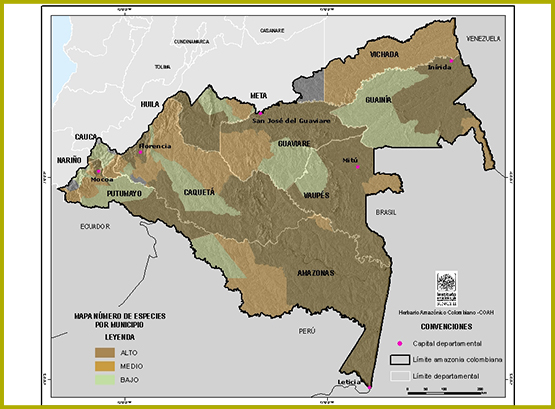This analysis is related to knowledge of the region measured in collections of botanical specimens and collection localities with fully identified species, it is measured by the number of records and by taxonomic determination of the records by biome, department and municipality.
Undertanding of the Flora by Biome
Of the eight biomes identified for the Colombian Amazon according to the Nap of Biomass (SINCHI, 2007), the one with the greatest number of species is biome Zonobiome Humid Tropical Amazonia - Orinoquia - ZBHT-AO, followed by the H-AO biome. In the table, the number of species is presented for each biome and the percentage of records for each of the Amazonian biomes can be seen in the graph.
{indicador_21}
{indicador_1}

Understanding the Flora by Department and Municipalities
The department of Amazonas presents the largest number of species with 60% of the total identified for the Colombian Amazon, the second is Caqueta with 48% of species, followed by Vaupes with 30% of species as presented in the following graph.
{indicador_10}
The tables show the number of species per municipality, where the municipalities of La Pedrera, Leticia, Miriti-Parana, Puerto Arica, Puerto Nariño, Puerto Santander, Tarapaca (Amazonas), Florencia, Puerto Rico, Solano (Caqueta), Cacahual, Inirida, Puerto Colombia (Guainia), El Retorno, San Jose del Guaviare (Guaviare), La Macarena, La Uribe (Meta), Mocoa, Puerto Leguizamo, Villagarzon (Putumayo), Mitu and Taraira (Vaupes) stand out due to the high number of species.
{indicador_22}
{indicador_23}
{indicador_24}
{indicador_25}
{indicador_26}
{indicador_27}
{indicador_28}
{indicador_29}
{indicador_30}
{indicador_31}

Headquarters Leticia: avenida Vásquez Cobo between calle15 AND 16
Florencia office: calle 31A # 2e 11 Los Pinos
San José del Guaviare office: calle 10 # 25a 06 Barrio El Dorado
Mitu sub-office: carrera 14 # 10 - 37 Centro
Puerto Leguízamo work station: carrera 3 N° 2 - 19, Barrio Centro
Puerto Asis sub-office: carrera 30 # 9 - 118 Barrio Modelo
Línea Anticorrupción:
[email protected]
Whistleblower channel
Bogotá office: calle 20 # 5 - 44
Phone: +57 (601) 4442060
Inírida sub-office: calle 21 # 9 - 22 Barrio Los Comuneros
office hours:
monday to friday from 7 a.m. to 12 p.m. and from 2-5 p.m.
office hours:
monday to friday 8 a.m. to 5 p.m.
E-MAIL: [email protected]
(los asuntos de carácter judicial serán igualmente atendidos por este correo electrónico)





